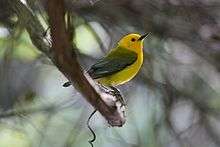Prothonotary warbler
| Prothonotary warbler | |
|---|---|
 | |
| Female | |
| Scientific classification | |
| Kingdom: | Animalia |
| Phylum: | Chordata |
| Class: | Aves |
| Order: | Passeriformes |
| Family: | Parulidae |
| Genus: | Protonotaria Baird, 1858 |
| Species: | P. citrea |
| Binomial name | |
| Protonotaria citrea (Boddaert, 1783) | |
 | |
| Range of P. citrea Breeding range Wintering range | |
The prothonotary warbler (Protonotaria citrea) is a small songbird of the New World warbler family. It is the only member of the genus Protonotaria.[2]
Taxonomy
Dutch naturalist Pieter Boddaert described the prothonotary warbler in 1783. This bird was supposedly named after certain prelates in the Roman Catholic Church known as protonotaries, due to its golden plumage (although protonotaries apostolic wear purple robes). It was once known as the golden swamp warbler.[3]
Description

The prothonotary warbler is 13 cm (5.1 in) long and weighs 12.5 g (0.44 oz). It has an olive back with blue-grey wings and tail, yellow underparts, a relatively long pointed bill, and black legs. The adult male has a bright orange-yellow head. Females and immature birds are duller and have a yellow head. In flight from below, the short, wide tail has a distinctive two-toned pattern, white at the base and dark at the tip.[4]
Distribution
It breeds in hardwood swamps in extreme southeastern Ontario and eastern United States. It winters in the West Indies, Central America and northern South America.[5] It is a rare vagrant to western states, most notably California.
Behavior and ecology
It is the only eastern warbler that nests in natural or artificial cavities, sometimes using old downy woodpecker holes. The male often builds several incomplete, unused nests in his territory; the female builds the real nest. It lays 3–7 eggs.
The preferred foraging habitat is dense, woody streams, where the prothonotary warbler forages actively in low foliage, mainly for insects and snails.
The song of this bird is a simple, loud, ringing sweet-sweet-sweet-sweet-sweet. The call is a loud, dry chip, like that of a hooded warbler. Its flight call is a loud seeep.[6]
Status
These birds are declining in numbers due to loss of habitat. They are also parasitized by the brown-headed cowbird (Molothrus ater), or outcompeted for nest sites by the house wren (Troglodytes aedon). It is listed as endangered in Canada. The species persists in protected environments such as South Carolina's Francis Beidler Forest, which is currently home to more than 2,000 pairs, the densest known population.[7]
In culture
The prothonotary warbler became known in the 1940s as the bird that, in front of the House Un-American Activities Committee, established a connection between Whittaker Chambers and Alger Hiss. Chambers had testified that Hiss enjoyed bird-watching, and once bragged about seeing a prothonotary warbler. Hiss later testified to the same incident, causing many members to become convinced of the pair's acquaintance.[8][9][10]
This bird is mentioned in A Sand County Almanac by Aldo Leopold as the "[J]ewel of my disease-ridden woodlot", "as proof that dead trees are transmuted into living animals, and vice versa. When you doubt the wisdom of this arrangement, take a look at the prothonotary." [11]
John James Audubon's painting of a prothonotary warbler is the third plate in his Birds of America.
Kurt Vonneguts' novel Jailbird: A Novel describes the warbler as "the only birds that are housebroken in captivity".
Gallery
 In a cavity nest
In a cavity nest Painting by John James Audubon
Painting by John James Audubon.jpg) Painting by Robert Ridgway
Painting by Robert Ridgway
References
- ↑ BirdLife International (2012). "Protonotaria citrea". IUCN Red List of Threatened Species. Version 2013.2. International Union for Conservation of Nature. Retrieved 26 November 2013.
- ↑ Curson, Jon; Quinn, David; Beadle, David (1994). New World Warblers. London: Christopher Helm. pp. 159–161. ISBN 0-7136-3932-6.
- ↑ Bird: The definitive visual guide. DK Publishing. 2007.
- ↑ Dunne, Pete (2006). Pete Dunne's Essential Field Guide Companion. Houghton Mifflin.
- ↑ Stiles, Gary; Skutch, Alexander (1989). A Guide to the Birds of Costa Rica. Cornell University Press. ISBN 0-8014-9600-4.
- ↑ Alderfer, Jonathan (2006). National Geographic Complete Birds of North America. National Geographic Society.
- ↑ "BirdWatching:Francis Beidler Forest, Harleyville, South Carolina". Feb 15, 2013.
- ↑ Chambers, Whittaker (1952). Witness. Random House. pp. 362, 564, 572, 573, 580. ISBN 0-89526-571-0.
- ↑ Linder, Doug (2003). "The Trials of Alger Hiss: A Commentary". Famous Trials. University of Missouri-Kansas City School of Law. Archived from the original on 2006-08-30.
- ↑ Miller, John J. (30 April 2007). "The Unsung Hero of the Cold War". National Review. Archived from the original on 10 October 2012.
- ↑ Aldo Leopold (1996). A Sand County Almanac. The Random House Publishing Group. p. 82.
External links
| Wikimedia Commons has media related to Protonotaria citrea. |
| Wikispecies has information related to Protonotaria citrea |
- "Prothonotary warbler media". Internet Bird Collection.
- Prothonotary warbler Species Account – Cornell Lab of Ornithology
- Prothonotary warbler - Protonotaria citrea - USGS Patuxent Bird Identification InfoCenter
- Prothonotary Warbler "The Swamp Songster" by Lisa Petit (January 1997) – Smithsonian Migratory Bird Center
- Prothonotary warbler recording at Florida Museum of Natural History
- Prothonotary warbler photo gallery at VIREO (Drexel University)
- Prothonotary warbler species account at NeotropicalBirds (Cornell University)
